Exploring Women's Jean Sets: Styles, Fit, and Trends
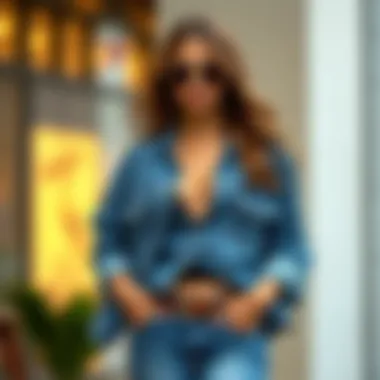
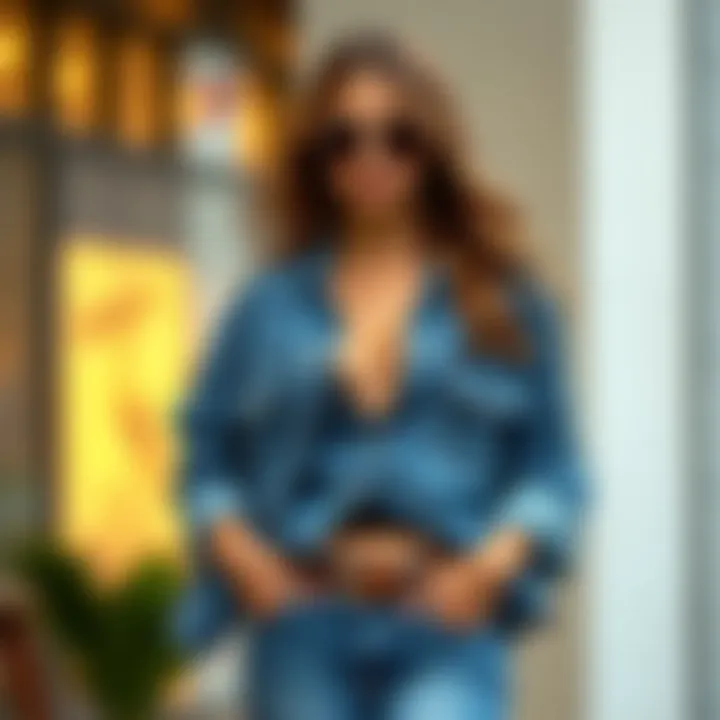
Intro
In today’s fashion landscape, women’s jean sets have transformed far beyond their humble origins. Once a staple of casual wear, they now symbolize a multifaceted expression of style and individuality. The evolution of denim, from rugged workwear to a runway essential, mirrors societal changes and reflects shifting attitudes towards fashion, sustainability, and personal identity. This article takes a closer look at the intricate world of women’s jean sets, offering a deep dive into their styles, fits, and cultural meanings.
Clothing Trends Analysis
Understanding clothing trends is crucial for anyone involved in fashion, from designers to stylists. Women's jean sets represent not just a garment but a canvas for creativity and expression. The current fashion scene showcases an array of denim styles, with a marked shift towards sustainability.
Current Trends in Seasonal Fashion
As we transition through seasons, denim trends adapt, offering various fits, washes, and styles. This year has seen a surge in wide-leg jeans and high-waisted options, with many enthusiasts opting for a 90s throwback. From cropped jackets paired with straight-leg jeans to oversized blazers worn over denim skirts, the versatility of jean sets allows for endless combinations.
Here are some trends that stand out this season:
- Sustainable Denim: Brands are increasingly focusing on eco-friendly production processes, emphasizing organic cotton and reduced waste in manufacturing.
- Vintage-Inspired Cuts: Fashionistas are increasingly leaning towards retro styles, including flared jeans and mom fits.
- Dark Wash Dominance: Dark indigo hues are returning as a preferred choice for both casual and formal occasions.
Iconic Styles Through Decades
Exploring the evolution of jean styles leads us through decades of societal shifts and fashion revolutions:
- The 1950s: The rise of denim skirts and slim fits symbolized emerging youth culture.
- The 1980s: Acid-wash and embellished jeans dominated, reflecting the vibrant pop culture of the time.
- The 2000s: Low-rise jeans became a mainstream phenomenon, embraced by many as a statement of freedom and partying spirit.
- Present Day: Currently, the focus is on body positivity, inclusivity, and personalization, where women choose jean sets that represent their unique styles and values.
"Fashion is the armor to survive the reality of everyday life." - Bill Cunningham
Styling Tips and Techniques
Navigating the realm of styling jean sets can sometimes feel daunting. However, simple yet effective techniques can help elevate any outfit.
Essential Tips for Wardrobe Versatility
When building an outfit around a jean set, versatility is key.
- Choose the Right Fit: Understanding your body type is essential for selecting the perfect jeans. High-waisted styles generally enhance the waistline, while straight-leg fits offer a flattering silhouette for almost any figure.
- Play with Colors: Don’t shy away from colored denim or unique washes. They can add a fresh twist to a familiar outfit.
- Accessorize Wisely: Scarves, hats, and statement jewelry can transform a simple jean set into a chic ensemble.
Layering Techniques for Effortless Looks
Layering adds dimension to outfits, providing warmth and style:
- Jackets and Blazers: A fitted blazer over a denim set can work wonders for a polished look. Opt for contrasting colors to ensure the denim stands out.
- Cardigans and Kimonos: Flowy outerwear like kimonos or lightweight cardigans can soften a rigid denim look while providing unexpected flair.
- Long Coats for Fall: Pair your jeans with a long coat as temperatures drop, adding a sophisticated edge.
In summary, the world of women's jean sets is not just about trends; it's about understanding oneself and expressing individuality through clothing. As some styles fade, others rise, but the overarching theme remains: denim is here to stay.
For additional references on fashion trends and styles, consider visiting Wikipedia or the British Fashion Council.
Explore discussions and insights on denim fashion on platforms like Reddit or follow industry leaders on Facebook.
Understanding Women's Jean Sets
Women's jean sets have become a staple in contemporary wardrobes, reflecting both personal style and cultural nuances. Understanding jean sets is not just about recognizing various styles or trends; it's about appreciating how these garments can serve as a canvas for self-expression, comfort, and functionality. As fashion continues to evolve, women’s jean sets offer an intersection between practicality and aesthetics, allowing individuals to navigate their days with confidence while staying stylish.
Definition and Components
To delve into women’s jean sets, one need to first recognize the definition and fundamental components of these outfits. A jean set typically consists of a pair of jeans and a coordinating top, often made of denim or similar fabric. The jeans can vary in cut, fit, and finish – from skinny to wide-leg, high-waisted to low-rise, and everything in between.
Additionally, the tops can range from casual tees and chic blouses to tailored jackets and oversized sweaters. Integrating different elements creates virtually endless combinations, making this style versatile and adaptable to various occasions, whether brunch with friends or a casual date night.
When considering a jean set, key components include:
- Fabric Quality: The type of denim matters; lighter weights offer breathability while heavier fabrics lend durability.
- Fit: Each body shape responds uniquely to cuts and styles; thus, finding the right fit is crucial for comfort and style.
- Color and Wash: Denim comes in a spectrum of hues and washes, from classic blue to ever-so-popular black or white, and each choice can significantly shift the outfit's vibe.
Understanding these components can help in selecting jean sets that not only look great but also make the wearer feel good.
Historical Overview of Jean Sets
The evolution of women's jean sets is a fascinating tale that intertwines fashion with social movements. Jeans originally gained popularity in the mid-20th century, initially as workwear. The sturdy design was a result of practical needs, as laborers and miners adopted denim for its resilience. As the years rolled on, jeans transitioned from the worksite to the forefront of fashion, particularly during the 1950s and 60s, when icons like Marilyn Monroe began incorporating them into their wardrobes.
Through the decades, their appeal only widened, fueled by cultural shifts and artistic revolutions. By the 1980s and 90s, jeans were firmly planted as an essential fashion item, embraced by women from all walks of life, showcasing individuality through various styles. The introduction of high-waisted mom jeans and distressed looks brought fresh interpretations that catered to different preferences.
In recent years, as sustainability and ethical fashion have come to the forefront, jean sets have been redefined yet again. Many brands focus on eco-friendly materials and responsible practices, making them more appealing to environmentally conscious consumers. Understanding the historical trajectory of jean sets enhances appreciation for their current place in fashion, celebrating both innovation and timeless style.
"Fashion is merely a form of ugliness so unbearable that we are compelled to alter it every six months." – Oscar Wilde
Women’s jean sets now don’t just represent personal style but a narrative steeped in history, culture, and social identity.
Exploring Fabric Options for Jean Sets
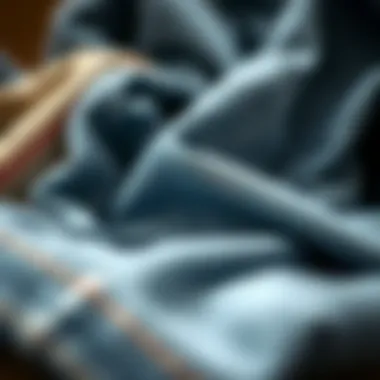
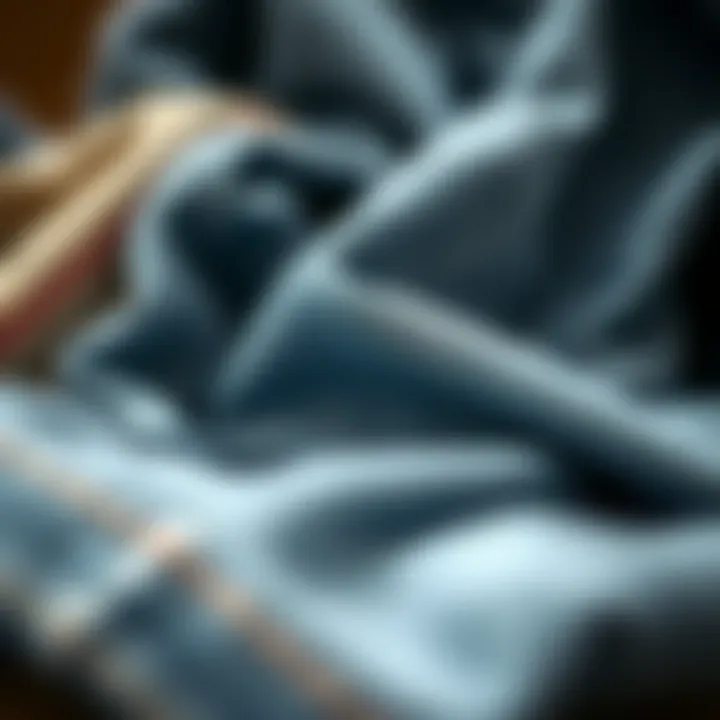
When considering women’s jean sets, fabric selection is a fundamental aspect that can dramatically influence both comfort and style. Fabric options affect not just the appearance of the jeans but also their fit, durability, and how they respond to different body types. Knowing the nuances between various materials can empower fashion designers, stylists, and students to make informed decisions that align with both aesthetic and practical needs.
Cotton vs. Synthetic Blends
Cotton has long been the fabric of choice for denim, prized for its breathability and softness. However, in recent years, synthetic blends have entered the scene, offering unique characteristics that can enhance jeans' functionality.
- Cotton’s Natural Appeal: Traditional 100% cotton denim provides comfort and is less likely to irritate the skin, making it a great pick for everyday wear. Cotton absorbs moisture effectively, which makes it cooler in warm climates. The feel of cotton adds a touch of authenticity to the whole outfit. Many individuals appreciate its organic origin, aligning with their values of supporting sustainable practices.
- The Advantages of Synthetics: Blends of cotton with synthetic fibers such as polyester or spandex come with their own set of benefits. These synthetic elements add durability, resistance to wear, and ease of care. For instance, polyester can help maintain the color better over time, reducing fading from regular washes. Spandex, on the other hand, provides excellent stretch, allowing jeans to accommodate movement. This results in a more comfortable fit, especially in styles like skinny jeans or fitted sets that demand elasticity.
It's worth mentioning that while cotton blends have their perks, they may not always be as breathable as pure cotton. Some might feel synthetic fabrics can lead to perspiration, particularly during the hotter months or in high activity settings.
"The choice between fabrics isn’t just about comfort; it's a balance of durability, look, and feel that defines the women's jean set experience."
Ultimately, selecting fabric boils down to personal preference and lifestyle needs. Whether leaning towards the classic feel of cotton or the innovative benefits of synthetic blends, understanding these fabric characteristics can help fashion enthusiasts craft the perfect jean set for any occasion.
Exploring Stretch Denim
Stretch denim has gained significant traction in the world of jeans. This fabric blends traditional denim with elastic fibers to create comfortable, fitted options that adapt to the body’s contour. Here are a few insights into why stretch denim is a vital trend in women’s jean apparel:
- Versatility: The elasticity of stretch denim allows it to be versatile in fit and style. Whether it’s high-waisted or a relaxed fit, stretch denim can mold to various designs and silhouettes, making it a popular choice in modern fashion. Its adaptability caters well to a wide range of body types.
- Comfort First: Women often prioritize comfort. Stretch denim allows for greater ease of movement without sacrificing style, making it ideal for both casual outings and structured environments alike. The blend with spandex gives enough give while retaining shape, thus preventing sagging over time.
- Fashion-Forward: With the rise of athleisure and casual wear, stretch denim has found its place in high-fashion contexts too. Brands have begun to integrate advanced technology to make stretch denim not just functional but also stylish. Alternative textile treatments enhance designs while maintaining comfort, appealing to fashion-savvy consumers.
To conclude, the choice of fabric in women's jean sets plays a pivotal role in both the garment's functionality and style statement. From the classic feel of cotton to the innovative stretch of blended materials, understanding these options enriches both the designer’s vision and the consumer’s wardrobe.
Popular Styles of Women's Jean Sets
In the dynamic landscape of fashion, understanding popular styles of women's jean sets is vital for both consumers and professionals alike. Jean sets not only reflect personal aesthetic preferences but also help in making statements about current trends and societal attitudes. These outfits represent versatility, allowing women to adapt their wardrobes to various occasions—whether it be casual outings, office wear, or social events. Embracing diverse styles empowers individuals to express their individuality while remaining stylish.
High-Waisted vs. Low-Rise
When venturing into the world of denim, one contentious issue is the ongoing rivalry between high-waisted and low-rise jeans. High-waisted options have surged in popularity recently. They tend to elongate the appearance of legs, creating a flattering silhouette for many body types. Women with hourglass figures particularly find high-waisted designs diminishing the waist and accentuating curves.
On the flip side, low-rise jeans have found their way back into wardrobes, often associated with a more laid-back, youthful vibe. They are often chosen for their comfort and casual appearance. Yet, they require careful styling to avoid the pitfalls of excess bulk or ill-fitting seams. Depending on personal comfort and style preferences, these two options cater to different looks, making high-waisted and low-rise jeans integral parts of any jean set collection.
Slim Fit vs. Relaxed Fit
Two prominent fits that have garnered significant attention are slim fit and relaxed fit styles. Slim fit jeans are synonymous with a tailored appearance, hugging the body closely from waist to ankle. This style is quite popular among trendsetters, as it lends an effortlessly chic look, making them suitable for various occasions, from work to dates. However, they might not carry the same comfort factor that some prefer when choosing their everyday wear.
Conversely, relaxed fit jeans embrace comfort without compromising on style. They offer more room in the leg area and create a laid-back silhouette perfect for leisure activities. This option resonates particularly with those who value ease over shape, seamlessly transitioning from casual outings to home lounging. In essence, the choice between slim fit and relaxed fit ultimately hinges on the wearer’s personal style and comfort needs.
Distressed Denim: A Fashion Statement
Distressed denim has become a hallmark of modern fashion, serving as a canvas for personal expression. This style evolves beyond mere aesthetic; it embodies a sense of individuality and creativity. Distressing techniques—ranging from subtle fraying to more pronounced rips—allow for innovative displays of style that can be effortlessly paired with various tops or accessories.
Furthermore, distressed jeans often come with stories; they carry an air of rebellion and nonconformity. This connection to cultural movements makes them much more than a piece of clothing. They resonate with fashion lovers seeking to merge casual wear with artistic expression, creating a visual narrative with every wear. Fountainhead of trends, distressed denim continues to solidify its place in jean sets, reflecting personal history and emotions.
"The choice of how to wear denim isn’t just about fit or style. It’s a language, a means to convey who you are without saying a word."
Choosing the Right Jean Set for Your Body Type
Choosing the right jean set for your body type is more than just a matter of aesthetics. It significantly influences the comfort, confidence, and practicality of your outfit. The right jeans can enhance your natural curves or create a balanced silhouette. With such a diverse range of styles and cuts available on the market today, understanding which jean fits best with your body type is crucial. This section will explore how to select the ideal jean set for various body types, ensuring that each woman can find her perfect fit.
Hourglass Figures and Jean Selections
For those blessed with an hourglass figure, the key is to choose jean sets that celebrate your curves without creating an unintentional muffin top or losing your waist definition. Opt for high-waisted jeans that sit above your natural waistline. This silhouette emphasizes the narrowest part of your body while giving a nod to your curves below.
- Best Options:
- Bootcut jeans to balance your figure and elongate the legs.
- Flared jeans which provide a retro vibe while complementing wider hips.
- Fitted skinny jeans can also work, but look for styles with a bit of stretch to avoid feeling constricted.
When picking styles, be cautious of low-rise jeans, as they can often clash with the natural curvature, leading to discomfort.
Athletic Builds: Finding Balance
For those with an athletic build, the goal is to create softer curves without losing the elegant straight silhouette. Opt for styles that add dimension to the hips while maintaining a balanced look overall, such as jeans with subtle flares or bootcut legs. Choose jeans that have a bit of stretch; this gives more freedom of movement while still providing a good fit.
- Recommended Cuts:
- High-waisted skinny jeans elevate the waistline and can create the illusion of curves.
- Relaxed-fit jeans can also be a great option, offering comfort and room without being baggy.
- Look for styles with unique embellishments or pockets, which can help draw attention to specific areas and add visual interest.
It's about mixing comfort with style while ensuring your jeans don't drown your frame.
Petite and Tall Options
When selecting jeans for petite or tall figures, the stakes can be even higher. The fit needs to enhance the natural proportions without making you look swallowed by fabric or overly elongated.
For Petite Figures:
- Keep your eye on cropped styles or ankle-length jeans that don’t overwhelm your frame. Avoid overly baggy or long jeans; they can make you look shorter.
- Style Choices:


- Straight-leg jeans that cut right above the ankle.
- Tailored, slim-cut jeans that hug the body.
For Tall Figures:
- Look for brands that offer longer inseams or styles specifically designed for taller women. Wider leg jeans can complement long legs nicely.
- Proven Styles:
- Wide-leg jeans that elongate the look of the legs.
- High-rise and wide-leg combinations which can create a sophisticated look while still being comfortable.
Finding the right fit can transform not just how you look but how you feel in your attire.
For more on jean selection by body type, check out resources like Wikipedia and Britannica.
Styling Tips for Women’s Jean Sets
In today’s fashion landscape, how one styles their clothing can make all the difference. Women’s jean sets, which often come in various fits, colors, and fabric compositions, provide a versatile foundation for numerous outfits. The way you choose to style these sets not only reflects your personal aesthetics but can also enhance your overall silhouette and comfort. Understanding the nuances of layering and accessorizing goes a long way in ensuring that you make the most out of your jean set.
Layering for Seasonal Looks
Layering is an art that can transform a simple jean set into a dynamic outfit fit for different seasons. During the cold months, consider incorporating heavier knits or longline cardigans over a fitted jean top. Not only does this keep one warm, but it also introduces texture to the ensemble, which can add visual interest. For those breezy autumn days, a tailored blazer perched atop a classic denim jacket can create an effortlessly chic look. The key is to balance lighter and heavier materials to avoid feeling overly bulky.
When it comes to layering, don’t shy away from color and patterns. A striped shirt layered under a solid colored jacket can break the monotony of a single-toned jean set. This tip also aligns with current trends where mixing and matching contrasting patterns has become quite stylish.
Here’s how you can approach layering:
- Choose contrasting length: Shift lengths, like a long shirt under a cropped jacket, for a balanced effect.
- Mix textures: Combine denim with fabrics like wool or tweed to create depth.
- Color coordination: Use complementary colors to create a cohesive palette.
Accessorizing with Jean Sets
Accessorizing is where the magic truly happens with jean sets. Accessories can serve as statement pieces that pull the entire look together. A bold necklace or statement belt can draw attention to your waistline, seamlessly adding dimension to your ensemble. Scarves, in particular, are a fantastic way to introduce an additional layer of style. A lightweight scarf can serve both as a practical item and a focal point in your outfit.
Beyond the usual suspects like bags and shoes, think about hats or hair accessories that can help to elevate your overall vibe. A wide-brimmed hat can evoke a laid-back, bohemian feel, while structured bags can add a polished finish to a more formal look.
To effectively accessorize your jean set:
- Pick a focal point: Select one statement piece that contrasts nicely with your outfit to stand out.
- Balance proportions: If wearing a loose top, pair it with fitted accessories, or vice versa.
- Mind the prints: Ensure your accessories either complement or provide a striking contrast to the patterns in your outfit.
"The best-dressed women in the room are always the ones who style their outfits with an element of surprise, thanks to clever layering and thoughtful accessories."
In essence, the way you choose to layer and accessorize your women’s jean sets can genuinely portray your unique style and personality. With fashion constantly evolving, it’s about refining what you wear to best reflect who you are.
Sustainability in Jean Production
Sustainability in jean production is no longer just a trend; it's becoming a cornerstone of ethical fashion. As the awareness of environmental issues grows, consumers are increasingly seeking out sustainable options, and the denim industry is responding. By adopting environmentally friendly practices, producers can reduce their carbon footprints and contribute to a healthier planet. This section elaborates on the elements that make sustainability essential, focusing on eco-friendly materials and ethical manufacturing.
Eco-Friendly Materials
When discussing sustainable jeans, the conversation often starts with materials. Traditional denim production consumes vast amounts of water and chemicals. However, innovative brands are pivoting to more sustainable alternatives. Here are a few materials to consider when evaluating eco-friendly denim:
- Organic Cotton: Grown without synthetic fertilizers or pesticides, organic cotton reduces the environmental impact significantly.
- Recycled Denim: Utilizing existing denim reduces the need for virgin materials, minimizing waste and resource use.
- Tencel: Made from sustainably sourced wood, Tencel is biodegradable and has a lower environmental impact compared to conventional fabrics.
- Hemp: This plant-based fabric grows quickly and requires fewer resources, making it a viable alternative to traditional cotton.
Adopting these materials is not just about crafting an eco-friendly product; it also appeals to a consumer base that values responsibility and sustainability. More brands are using these materials to craft their jeans. Plus, utilizing these fabrics often results in unique textures and styles that stand out in a crowded market.
Ethical Manufacturing Practices
Alongside materials, the manufacturing process plays a vital role in the pursuit of sustainability. Ethical practices ensure that workers are treated fairly and that production methods don't harm the environment. Key considerations include:
- Fair Wages and Working Conditions: Brands that prioritize ethical labor practices ensure workers receive fair wages and operate in safe environments.
- Low-Impact Manufacturing: Techniques that minimize water and energy consumption during production help to reduce the ecological footprint of denim production.
- Chemical Management: Responsible management of the chemicals used in dyeing and finishing ensures that waste does not endanger local ecosystems.
- Transparency: Consumers are demanding to know where and how their clothes are made. Brands that disclose their practices build trust and loyalty.
In an age where consumers are more conscious of their choices, businesses must take these ethical manufacturing practices seriously. By prioritizing sustainability, brands not only do their part for the environment but also create products that resonate with a mindful audience.
The Cultural Impact of Denim
Denim holds a unique place in the tapestry of fashion and culture, especially when it comes to women's jean sets. This fabric has transcended its origins as a workwear material to become a symbol of expression and identity across different social spectrums. Understanding this cultural impact is essential for anyone engaged in fashion, whether designers, stylists, or students.
The significance of denim can be appreciated on several levels:
- History and Evolution: Originally crafted for durability in the 19th century, denim found its way into the wardrobes of various social classes. Its transformation reflects societal shifts, from laborers in the American West to a staple in high-fashion collections.
- Cultural Representation: Denim has often represented rebellion and individuality, particularly in youth cultures. It has played a pivotal role in movements, resonating strongly with those seeking to challenge norms.
- Modern-Day Reflections: Today, denim is a canvas showcasing diverse styles—from classic cuts to avant-garde designs—enabling wearers to express their unique personalities.
Focusing on denim’s multifaceted nature allows fashion professionals to grasp its far-reaching implications on clothing choices and broader cultural narratives.
Denim as a Symbol of Rebellion
Denim can very much be seen as a garment that represents resistance and the quest for freedom. It emerged as a fashion statement during the counterculture movements of the 1960s and 1970s, notably among those who rejected conventional societal standards. Jeans became a form of non-verbal communication, conveying a sense of defiance against the status quo.
"Denim isn't just fabric; it's a statement, a stance, a soft rebellion against what society deems acceptable."
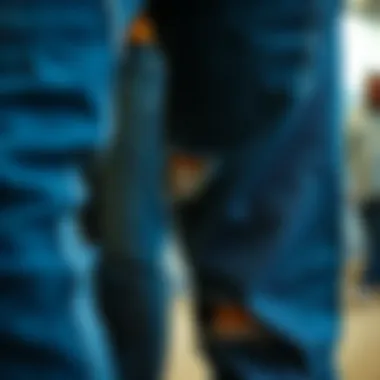
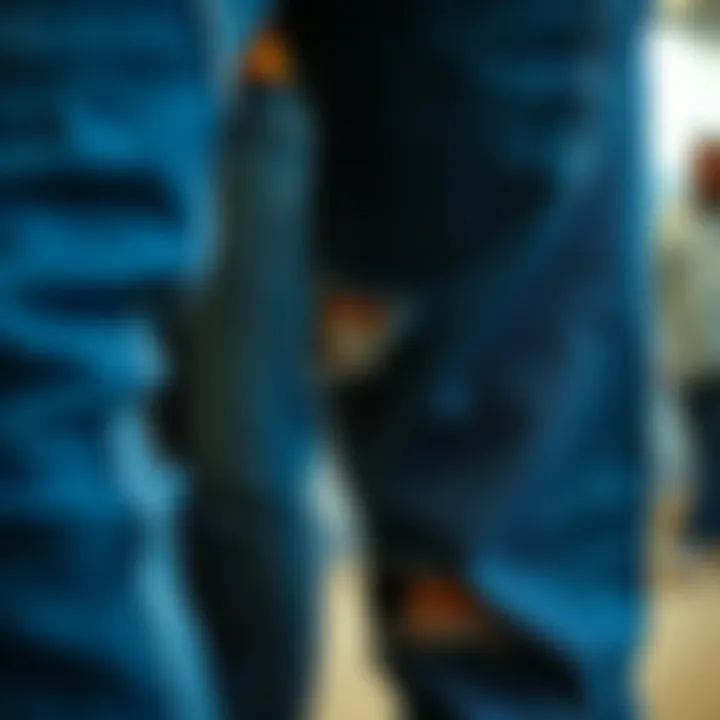
- The Counterculture and Protest: Civil rights, women's liberation, and anti-war movements all found a voice through denim styles, often changing how garments were perceived. The classic skinny jean or distressed style symbolized not just fashion preferences but ideological alignments.
- Fashion as Protest: Newer generations continue to adopt denim to project individuality and dissent. Unique embellishments or upcycled pieces allow wearers to craft their narratives, further solidifying denim's role as a medium for personal expression.
Influences of Celebrity Fashion
Celebrity influence in fashion is not merely about wearing what’s trendy; it extends to what those choices signify culturally. Women’s jean sets frequently wind up in the limelight, garnering attention whenever a high-profile figure dons them. When celebrity style icons choose denim, their selections often become talking points, setting the stage for fashion trends.
- Red Carpet to Street Style: It's interesting to observe how a pair of jeans worn at a high-profile event can shift the perception of denim from casual to chic. Stars like Rihanna and Gigi Hadid frequently sport elevated styles that push the envelope of traditional denim.
- Social Media Amplification: Platforms like Instagram and TikTok allow for instant dissemination of celebrity fashion choices, encouraging fans to adopt similar looks. The hashtag #denimstyle regularly trends, bringing new ideas into the mainstream.
- Sustainable Choices: Celebrities increasingly advocate for sustainable fashion. From endorsing eco-friendly jean brands to promoting vintage shopping, this advocacy shifts consumer focus toward more conscious purchasing behaviors.
Through understanding the interrelationship between denim, rebellion, and celebrity influence, enthusiasts and professionals can appreciate not only the aesthetic potential of women's jean sets but also their significance in cultural dialogues.
Current Trends in Women’s Jean Sets
Staying updated with the latest trends is essential in the fashion world, especially when it comes to women's jean sets. This segment not only reflects the passage of time but also encapsulates cultural shifts and personal expression. Today's consumers are increasingly seeking garments that showcase individuality and align with contemporary values. Understanding these trends helps designers, stylists, and fashion students craft collections that resonate with modern clientele.
The Rise of Vintage Styles
One of the most prominent trends in recent years is the resurgence of vintage styles in women's jean sets. This doesn't just refer to the materials or cuts; it's about embracing an entire aesthetic that draws on inspirations from past decades. Think of flared jeans reminiscent of the 70s or high-waisted designs that give a nod to the 80s. This shift towards vintage styles signals a desire for authenticity and nostalgia in fashion. Consumers find themselves gravitating towards pieces that tell a story, and this is where vintage comes into play.
The allure of vintage jean sets can be attributed to several factors:
- Sustainability: Many shoppers today are conscious of their environmental impact. Vintage clothing often reduces the demand for new materials, aligning with sustainable fashion practices.
- Uniqueness: Wearing vintage means often sporting one-of-a-kind pieces. This allows individuals to stand out from the crowd, offering a personal touch that mass-produced items simply cannot.
- Quality Craftsmanship: Older jeans sometimes feature superior construction and materials, yielding longer-lasting garments.
Moreover, thrift stores and online reselling platforms have made access to vintage jean sets easier than ever. Shoppers enjoy the thrill of hunting for unique finds, which adds an element of fun to the shopping experience.
Collaborations in Fashion
In recent years, the trend of collaborations in fashion has taken the industry by storm. High-end designers team up with mass-market brands to create exclusive women's jean sets that balance style with affordability. Notable collaborations have introduced creative designs and ethnic looks into denim fashion.
These partnerships often bring fresh ideas to the table, pushing boundaries of traditional denim attire. For instance, a collaboration between a luxury brand and a streetwear label can result in a striking pair of jeans that blends elegance with edge. This phenomenon allows consumers to incorporate high-quality fashion statements into their wardrobes without breaking the bank.
The benefits of such collaborations are manifold:
- Broader Audience Reach: High-end brands often tap into a younger, more diverse market through collaborations.
- Innovation: Combined expertise results in innovative designs and materials, keeping the brand essence while pushing the envelope.
- Limited Editions: Collaborative pieces often come in limited runs, creating a ‘must-have’ appeal that can generate buzz and excitement around launches.
As we examine these current trends, it becomes clear that women’s jean sets are not just about functionality or style—they embody a blend of culture, sustainability, and individual expression. These trends offer designers and stylists a fertile ground for inspiration, paving the way for future innovations and unique ensembles.
"Fashion is a language that creates itself in clothes to interpret reality.” – Karl Lagerfeld
For more on fashion trends, you can explore resources like Wikipedia and Britannica.
Care and Maintenance of Jean Sets
When it comes to women’s jean sets, understanding the right care and maintenance practices can significantly prolong their life and keep them looking sharp. Jeans are not just garments; they often serve as a canvas for personal expression. Properly maintaining them can ensure they remain a staple in one's wardrobe for years to come. Accumulating dirt, fading, and wear can transform your favorite pair of jeans into something less desirable. Let's delve into some essential care techniques.
Washing and Drying Techniques
Washing denim often raises questions—how frequent should it be, and what’s the right way to go about it? Here are a few guidelines to steer you in the right direction:
- Frequency of Washing: Contrary to what some may think, jeans don't need to be washed after every wear. For those whose jeans remain mostly clean, washing them once every few wears should be sufficient. Over-washing can lead to fading and weaken the fabric, so allow them to breathe a bit.
- Cold Water is Key: Always wash your jeans in cold water. This minimizes color fading and helps maintain the integrity of the fabric. Hot water can be too harsh and may cause shrinkage.
- Gentle Cycle: Use the gentle cycle on your washing machine. This ensures a milder wash, reducing friction that can lead to wear and tear over time.
- Detergent Choice: Opt for a mild detergent specifically designed for dark fabrics if your jeans are in darker hues. This can help preserve colors for longer. Avoid bleach as it can ruin the fabric and the color.
- Air Dry Setting: When it comes to drying, ditch the dryer. Instead, hang drying your jeans helps avoid shrinkage and maintains their fit. If you must use a dryer, choose the lowest heat setting and remove them while still slightly damp to avoid excessive wrinkling.
P.S. Some folks swear by freezing their jeans instead of washing them to kill odor-causing bacteria. It may sound odd, but it’s a popular trick!
Storing Jean Sets Properly
After washing and drying your jeans with care, how you store them plays a critical role in maintaining their shape and appearance:
- Fold, Don’t Hang: It’s usually best to fold jeans instead of hanging them in a closet. Hanging can stretch the fabric over time, particularly in the knee and seat areas. A neatly folded stack also looks tidy and easy to access.
- Avoid Direct Sunlight: Store jeans in a cool, dry place away from direct sunlight. UV rays can cause colors to fade and weaken the fibers, diminishing the overall look of your jean set.
- Use Organizers: Consider utilizing drawer dividers or fabric boxes to separate different styles and cuts. This not only keeps them neat but also makes it easier when you're picking out outfits.
- Check Condition Regularly: From time to time, check your stored jeans for any issues like moth holes or fabric fraying. Catching these early can save you from losing a favorite pair.
Remember, taking the time to care for and maintain your jean sets can pay off in dividends down the line. Not only do well-maintained jeans last longer, but they also look better, providing you with more confidence in your style choices.
Future Innovations in Jean Apparel
In the ever-evolving realm of fashion, the future of women's jean apparel stands at a fascinating crossroads. It's not just about aiming for the latest trend, but also about incorporating technology and sustainability into the fabric of our daily lives. The innovations in this sector reflect a growing awareness of both consumer preferences and environmental concerns, as designers push the envelope to create something that marries style with practicality. Embracing future innovations will allow for more than just aesthetic enhancements; it paves the way for functional, personalized, and eco-conscious choices.
Smart Textiles and Functionality
As the world becomes increasingly interconnected, the application of smart textiles within jean sets is gaining ground. Imagine a pair of jeans that not only fits like a glove but also adapts to your body temperature or even tracks your activity levels. This isn’t mere science fiction; several companies are currently experimenting with fabrics that can respond dynamically to environmental changes.
- Temperature Regulation: Certain high-tech fabrics can wick away moisture or trap heat, ensuring comfort throughout various conditions. This feature alone can make wearing jeans in summer or winter seasons a breeze.
- Activity Monitoring: Wearable technology embedded into the fabric can provide data on physical activity, sleep quality, or even stress levels. This could revolutionize how we approach health and fitness, merging style with function.
- Durability: Innovations in chemical treatments and fabric blends can lead to jeans that resist stains, odors, and wear, extending the life of the jeans significantly.
These advancements don’t just enhance individual utility; they allow brands to respond to a more health-conscious society, setting a new bar for what we expect from everyday wear.
Customization and Personalization Options
Customization is no longer a luxury; it’s fast becoming the norm in the apparel industry. Consumers are increasingly seeking options that allow them to express their individuality. In the context of women’s jean sets, this trend manifests in several exciting ways:
- Tailored Fit: Many brands are moving toward offering customizable fit options where shoppers can input their measurements, resulting in jeans that fit them to perfection.
- Design Your Own: From color selection to embroidery options, the chance to co-create a piece can foster a deeper connection between the consumer and the product. Some platforms even allow customers to choose pocket styles, button designs, and stitching colors.
- Limited Editions: Many designers are now releasing limited runs of unique designs, encompassing cultural or thematic influences that resonate strongly with consumers.
This trend not only celebrates individual creativity but also streamlines inventory for companies, resulting in more demand-driven production, thus minimizing waste.
"Customization empowers individuals by transforming fashion consumption into a personal expression of identity."
As we look ahead, the infusion of smart textiles and customization will shape the way women embrace jean sets. This is not just about what you wear but also about how your clothes can work for you in ways that were once thought impossible. Innovations in jean apparel are steering the industry towards a more sustainable, functional, and personalized future.







